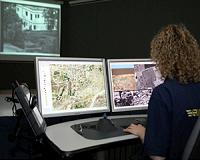| . |  |
. |
Damascus, Syria (UPI) Jul 20, 2010 Women in Syria are barred from wearing the niqab full-face veil while attending university, the minister of higher education said. The decree follows a pronouncement by his counterpart, the minister of education, that disallowed fully veiled schoolteachers in lower and infant schools. Last month, around 1,200 schoolteachers wearing the face veil were dismissed from their jobs, Syrian media said. The ban in universities was done to promote moderation within society, the Minister of Higher Education Ghiath Barakat said. He said he made the decision based on the requests of parents who demanded their daughters be educated in a place that is free aspects of extremism. Concern over the use of the veil was highest among parents whose children attended private universities. Barakat also discussed the issue with presidents of universities this week, a spokesman for the education ministry said. "The minister declared his objection to the face veil which, he argued, is against academic principles and campus regulations," the official said. "The minister said Syria has always been capable of warding off several attempts at implanting subversive thought in its society and has managed to conquer all those ideological invasions. He also called for raising awareness of these potential threats among youths." The Syrian banning isn't uncommon in mainly Islamic states whose government's are striving to maintain a secularist-leaning society in the face of growing conservative religious influence. But it is also not uncommon to have differences among clerics about what is or isn't allowed for women, from a simple headscarf covering only the hair to a full body covering with only a netting allowing eyesight. In late 2008 a Muslim cleric in Saudi Arabia, where the niqab is common, called on women to wear a niqab that reveals only one eye. Sheik Muhammad al-Habadan said showing both eyes encouraged women to use eye makeup to look seductive. But in Egypt in late 2009 a senior Muslim authority declared he was against the growing trend for women to wear a niqab. Sheik Mohamed Tantawi, dean of al-Azhar university, said full-face veiling had nothing to do with the Islamic faith. Tantawi reportedly visited a girl's school in Cairo and asked one of the students to remove her niqab, telling her it was a tradition and not a religious requirement. Attitudes toward Muslim woman wearing a niqab are hardening in Western Europe, with France the latest country moving toward banning them completely. The proposed ban, supported by President Nicolas Sarkozy, comes out of an earlier ban on teachers and pupils at state schools wearing any overt symbol of their religion, be it a Christian cross or head scarf. A majority of members in France's lower house of parliament, the National Assembly, voted this month for a bill banning wearing the full veil in public. But the bill must be ratified by the upper house, the Senate, in September before becoming law. Many opposition Socialists, who wanted the only in public buildings, abstained from voting. If France's proposed ban becomes law, women wearing a niqab, and men who force them to do so, would face a fine of up to $190.
Share This Article With Planet Earth
Related Links The Long War - Doctrine and Application
 9/11 attacks spawned big US government: report
9/11 attacks spawned big US government: reportWashington (AFP) July 19, 2010 The US intelligence network created after the September 11, 2001 terror attacks is so unwieldly even principal actors within it are unable to grasp its size, according to a two-year probe by the Washington Post published Monday. The newspaper's investigation found that nine years after the attacks on New York and Washington, the bureaucracy has become "so unwieldy and so secretive that no on ... read more |
|
| The content herein, unless otherwise known to be public domain, are Copyright 1995-2010 - SpaceDaily. AFP and UPI Wire Stories are copyright Agence France-Presse and United Press International. ESA Portal Reports are copyright European Space Agency. All NASA sourced material is public domain. Additional copyrights may apply in whole or part to other bona fide parties. Advertising does not imply endorsement,agreement or approval of any opinions, statements or information provided by SpaceDaily on any Web page published or hosted by SpaceDaily. Privacy Statement |